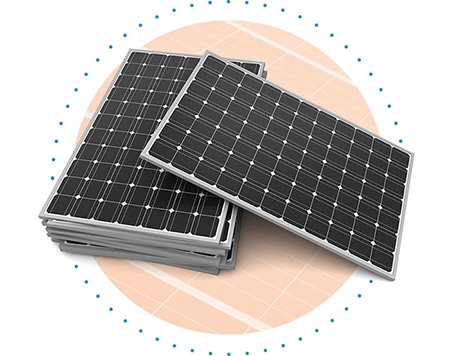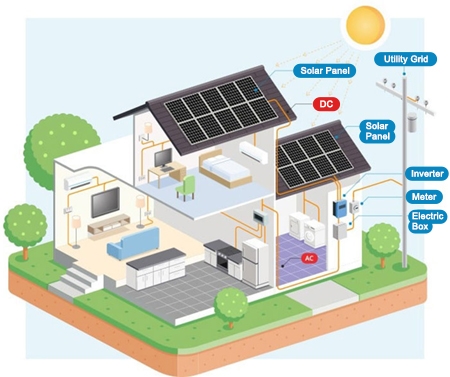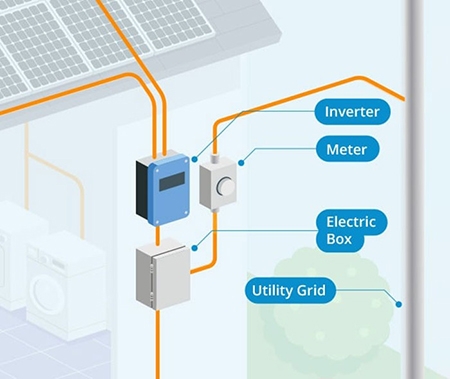The sun gives you free energy. We can help you harvest it and save today. The sun is basically a nuclear reactor. It releases tiny bits of energy called photons. These photons then travel 93 million miles from the sun to Earth in about 8.5 minutes. The sun emits enough photons in one hour to generate enough power to meet global energy requirements for an entire year. That is an amazing statistic.
Solar panels, also known as photovoltaic panels, are devices that convert sunlight into electricity. They consist of multiple solar cells that capture sunlight and generate an electric current through the photovoltaic effect. Solar cells are mainly made of silicon and are categorized into two types: Monocrystalline and polycrystalline, with monocrystalline being more efficient but also more costly. When sunlight strikes a solar cell, photons (i.e., units of light energy) excite electrons in the cell to produce an electric current. This process does not involve any mechanical moving parts, so solar panels operate quietly and are low-maintenance.
How Solar Panels Work
Phosphorus is seeded into the top layer of silicon, which adds the extra electrons needed to get a negative charge. The bottom layer is treated with boron, which subtracts electrons, giving it a positive charge. This creates an electric field at the junction of these two silicon layers. When a photon of sunlight hits the photovoltaic cell, an electron is knocked free. The electric field pushes the electron out of the silicon junction, creating energy.
Each photovoltaic cell is made up of two slices of semi-conducting material, usually silicon. The cells have a positive and negative layer that together create an electric field, much like a magnetic field or battery that needs both a positive and negative charge to work. To get this electric field, additional materials to each “slice,” giving them either a positive or negative electrical charge.

Solar panels work by letting photons released by the sun knock electrons free from atoms, and thus generate a flow of electricity. Solar panels are composed of many smaller photovoltaic cells linked together. The more panels you deploy, the more energy you generate. Solar panels work by letting photons released by the sun knock electrons free from atoms, and thus generate a flow of electricity. Solar panels are composed of many smaller photovoltaic cells linked together. The more panels you deploy, the more energy you generate.
Each photovoltaic cell is made up of two slices of semi-conducting material, usually silicon. The cells have a positive and negative layer that together create an electric field, much like a magnetic field or battery that need both a positive and negative charge to work. To get this electric field, we add other materials to each “slice,” giving them either a positive or negative electrical charge.
Phosphorus is seeded into the top layer of silicon, which adds the extra electrons needed to get a negative charge. The bottom layer is treated with boron, which subtracts electrons, giving it a positive charge. This creates an electric field where these two silicon layers meet. When a photon of sunlight hits the photovoltaic cell, an electron is knocked free. The electric field pushes the electron out of the silicon solar cell, creating energy.
State of the Art Roofing Technology
Currently, solar power provides less than 2 percent of the power generated in the United States. But as solar technology improves and the cost of adding solar drops, our ability to capture and use the sun’s abundant energy is increasing. In fact, the 2019 International Energy Agency Renewables Report showed that solar power is the fastest growing renewable energy source – and will make up 60 percent of new renewable-based power capacity globally over the next five years. This is the first time solar energy capacity surpassed any other fuel as a source of power. In the coming years, we all will be using solar power, whether we realize it or not. This also means that the time is right to invest in solar power for your home.
How Does Solar Energy Work
Once solar panels are installed on your roof and begin to create energy, there are a few steps required to turn it into energy your home can use. As the sun hits the solar panels, they generate direct current (DC) electricity, where the electrons flow around a circuit in one direction. In order for your home to use this energy, it must be converted from DC electricity to alternating current (AC) electricity, where the electrons are pushed and pulled. When you have solar panels installed on your power your off grid living, you will also have a solar inverter installed. The solar inverter changes the DC output of the solar panels into AC electricity that your home can use.

How Does Net Metering Work
When your solar panels produce more energy than your home needs at any one time, you may wonder where that energy goes. That energy is sent back to the power grid and you get credit for it on your electric bill. This process is called net metering, and it' s one of the great things about solar. In essence, your roof is producing energy and sending the excess back into the electric grid through the meter on your home. This allows you to benefit from all the energy your home produces. When your home needs more energy than your solar panels are producing, you can use the energy credits from your excess energy to reduce your energy bill. Not every utility company offers net metering, but for those that do, it's a great benefit for those who add solar.

To simplify all this, here is a step-by-step guide to how solar energy works:
- Step 1: Sunlight reaches the solar panels, and they start working to generate an electric current (DC).
- Step 2: The electric current (DC) starts to flow into the inverter, which is responsible for changing DC electricity into AC, which is the most common form of electricity.
- Step 3: The AC electricity moves from the inverter to the breaker box. Then, the current moves into any appliance in the home/building using electricity.
- Step 4: Unused electricity moves back to the utility meter and into the grid. You get a credit for that on your electric bill. When your home needs more energy than what is produced by your solar panels, electricity will be drawn from the grid.
How Do Solar Panels Work on Your Home
- That’s a lot of technical information about how solar panels work, so let’s look at how a solar panel array would work on your home. First, sunlight in the form of photons hit the solar panels on your roof or ground mount. The portable pv panels convert the energy from freed electrons to DC current, which then flows to an inverter and is converted from DC electricity to AC electricity.
- This electricity is then used to power your home. It’s simple and clean, and it's becoming more efficient and affordable. However, what if you are not home? You may not be using the electricity your solar panels generate. What happens at night, when there is no sunlight and your system is not generating power? Not to worry, you still can use the energy your system has created. This is where net metering comes in.
What Happens to Excess Energy
A typical solar panel panel installation connected to the power grid produces more energy that you can use during peak sunlight hours. That excess energy goes back into the grid and can be used by you or someone else. You get a credit for the excess energy your system produces. When needed, you can draw on that credit to get power from the grid during the night. A two-way meter keeps track of the energy sent to the grid along with the energy received from it.
Solar Panels Work with Grid Connection
- Although most people understand that solar panels help them generate their own power so that they don’t have to depend solely on the power company, there is still confusion about the role the grid plays in home solar energy systems.
- Homes that are connected to the electrical grid have a utility meter that measures how much electricity you use. If you have net metering, when your solar power system is overproducing, you send the excess power to the grid in exchange for credits on your bill. Then, during hours of low production, such as the nighttime, you use your credits to meet your home’s energy needs. Net metering gives you a way to store your energy and use it when you need it. This significantly improves the economics of solar power.
As technology advances, the efficiency of solar panels is increasing and the cost is gradually decreasing, making solar energy an increasingly practical source of renewable energy. By utilizing solar energy, we can not only reduce our dependence on fossil fuels, but also reduce environmental pollution and contribute to a sustainable future. Not only does solar technology provide clean, renewable energy for homes and businesses, it is also important for reducing greenhouse gas emissions and combating climate change. To learn more about solar panels, you can visit the relevant pages on the PowerHome website: What is a Solar Panel? and Solar Panel Buying Guide.
(1).png)
(1).png)